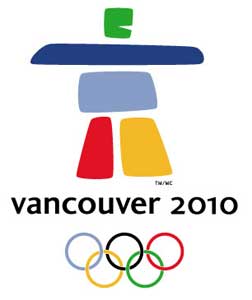The closest I ever got to the Olympics was the USOC training center in Colorado Springs where I received sports nutrition training. As I write this, The USOC dietitians are in Vancouver with Team USA making sure they are well hydrated and fueled while they go for gold.
But what exactly do Olympic athletes need to eat? You probably heard the stories of Michael Phelps chowing down on 10-15,000 calories a day! It sounds like a dream come true. Believe it or not, many of the winter sports require smaller body sizes to excel. It’s no wonder there is concern for eating disorders to develop among athletes.
For example, the ski jumper must be tall and thin so their goal is to have a low BMI – 5′ 11″ and 140 pound male (model thin). Suzie Parker Simmons, a sports dietitian at USOC, says that ski jumping is problematic because the sport requires strength, power and low weight. “Because it’s a power sport, endless hours of fat-burning running [to reduce weight] is counterproductive athletically—explosive power for ski jump demands fast-twitch muscle fibers, not the slow-twitch fibers developed by endurance sports. That means caloric restriction, not extra exercise, is the primary means of keeping body weight low.”
You might think that athletes must eat some kind of super food to do what they do. But they really don’t have different nutrition needs than the average healthy person. They need to eat a variety of healthy foods just like everyone else. Some athletes may need more carbohydrates, which means protein and fat intake has to decrease, or they could gain weight.
Nanna Meyer, the nutritionist for United States Speed Skating, says an intense training day for a skater demands about 7 to 10 grams of carbohydrate per kilogram of body weight, at least 1.5 g/kg of protein, and about 1g/kg of fat. (Less intense exercise means fewer carbs—more like 5 to 7 g/kg.) These nutrition needs are similar to endurance athletes (even if you aren’t Olympic calibur).
The other thing athletes have to deal with is appetite. If their appetite is low, but calorie needs are high, liquid calories are a viable option. It would not be unusual for an athlete to have 1-2 smoothies a day. They are easy to drink and high in calories at about 500 a pop. Oatmeal is a popular breakfast item in the cold mountains of Vancouver. Adding in raisins and nuts and making it with milk all adds calories and nutrition for the athlete.
Recovery nutrition is huge for athletes. Worst case scenario, they will drink a sports beverage and eat a bar like a Clif or Powerbar because they are convenient and meet their needs for recovery nutrition and hydration until their next meal.
Watch and cheer on Team USA during these Olympics and be amazed by what they are able to do. It’s motivating. Just remember, they wouldn’t be able to do it without good nutrition.
What good nutrition habit will you start this week?
Also Read:
Eating Advice from Female Olympic Athletes

